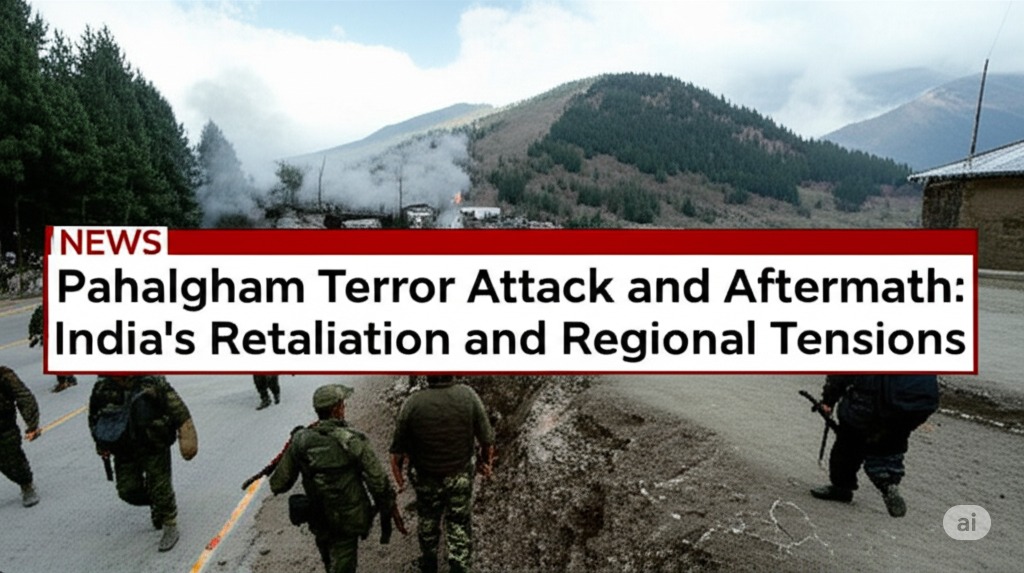Pahalgam Terror Attack and Aftermath: India's Retaliation and Regional Tensions
Published on May 26, 2025 | Generated by AI
 🤖 AI-generated Image
🤖 AI-generated Image
Why It Matters
The terrorist attack in Pahalgam, Jammu and Kashmir, on April 22, 2025, which resulted in the deaths of 26 individuals, including 25 Indian citizens and one Nepali national, has significantly escalated tensions between India and Pakistan. The brutal targeting of tourists highlighted the persistent threat of cross-border terrorism and its direct impact on civilian lives and the vital tourism sector in the region. This incident triggered immediate security concerns, leading to the closure of numerous tourist destinations and prompting a robust response from the Indian government. The attack brought the issue of state-sponsored terrorism back to the forefront of international discourse and became a critical test for India's national security posture and diplomatic strategy.
Background & Timeline
Following the April 22 attack in Pahalgam, India swiftly condemned the act and signalled a departure from conventional responses. High-level security meetings were convened, culminating in Prime Minister Narendra Modi granting the armed forces "full operational freedom" to determine the nature and timing of their response. Investigations into the attack commenced, with the National Investigation Agency (NIA) taking over the probe, employing advanced techniques like 3D mapping. Simultaneously, diplomatic pressure mounted, with India strongly criticizing Pakistan at international forums, including the United Nations, labeling it a "rogue state." Amidst rising tensions and reports of Pakistani military movements, India began considering measures such as restricting Pakistani access to its airspace and ports. These initial reactions set the stage for a more assertive counter-terrorism approach from India.
What’s Happening Now
- May 7, 2025: In response to the Pahalgam attack, India launched "Operation Sindoor," a coordinated military operation targeting nine terrorist camps and infrastructure sites across Pakistan and Pakistan-occupied Kashmir (PoK). The strikes, conducted by the Army, Air Force, and Navy using precision munitions, aimed to dismantle facilities of groups like JeM, LeT, and Hizbul Mujahideen, reportedly causing significant casualties among terrorists. India briefed 13 countries and UNSC members, emphasizing the strikes were preemptive and non-escalatory, targeting only terrorist infrastructure.
- May 7-10, 2025: Following "Operation Sindoor," tensions escalated sharply. Pakistan condemned the strikes as an "act of war," authorized its military to take "corresponding actions," and initiated artillery fire along the Line of Control (LoC), resulting in Indian civilian and military casualties. Pakistan also allegedly launched drone and missile attacks targeting Indian cities and military bases, which India claims to have repelled, reporting the downing of Pakistani jets and destruction of air defenses. Airspace restrictions and temporary airport closures were implemented in northern India.
- May 10, 2025: Amidst heightened hostilities, Pakistan initiated contact with India, leading to direct talks between the Directors General of Military Operations (DGMOs). A ceasefire agreement was reached, effective at 5 pm IST, halting military actions across land, air, and sea. While some international actors, including former US President Donald Trump, claimed mediation, India asserted the ceasefire was agreed upon directly after Pakistan's request.
- May 10-12, 2025: Despite the ceasefire, reports of violations emerged, including drone intrusions and shelling in Jammu and Kashmir and Punjab, leading to renewed security alerts and precautionary blackouts in some areas. India condemned these violations, reiterating its firm stance against terrorism and stating that its position on diplomatic measures, including the Indus Waters Treaty, remained unchanged. Dialogue between military officials was scheduled to reinforce the ceasefire understanding.
- May 13-26, 2025: Tensions persisted with intermittent reports of drone sightings and security incidents. Prime Minister Modi asserted that "Operation Sindoor" was paused but not over, emphasizing a new security doctrine against terrorism and nuclear blackmail. India continued diplomatic efforts, including briefing global partners and countering Pakistan's narrative at the UN. India also implemented economic measures, including the suspension of the Indus Waters Treaty and trade restrictions, and took action against entities perceived to support Pakistan. Pakistan acknowledged Indian strikes on its airbases and faced international scrutiny, while internal political and economic challenges added complexity to its response.
What Could Happen Next
-
1. Conditional De-escalation Holds: The current fragile ceasefire, contingent on the complete cessation of military actions and drone incursions from Pakistan, manages to prevent large-scale conflict. Periodic low-level incidents along the LoC may occur, but are contained through existing military hotlines and communication channels. Diplomatic engagement remains limited, focused primarily on maintaining the truce, while India maintains its assertive posture on counter-terrorism and continues economic pressure, potentially influencing Pakistan's internal stability and its approach towards terror groups.
2. Renewed Cycle of Conflict: A significant ceasefire violation or a new, high-impact terrorist attack triggers a more forceful and potentially broader retaliatory response from India, similar to or exceeding "Operation Sindoor." This could lead to open military confrontation involving multiple sectors along the border and potential targeting of wider military or strategic assets, escalating tensions to a level requiring urgent international intervention to prevent a wider regional conflict with severe humanitarian and economic consequences.
3. International Pressure and Diplomatic Resolution: Increased and sustained international pressure, possibly coordinated by global powers or multilateral organizations, compels Pakistan to take verifiable action against terrorist groups operating from its soil. This could lead to a negotiated process aimed at addressing the root causes of cross-border terrorism, potentially involving structured dialogue, monitoring mechanisms, and confidence-building measures, paving the way for a more stable, albeit cautious, long-term relationship between India and Pakistan.
This article is generated using AI-assisted summaries and verified timelines.
